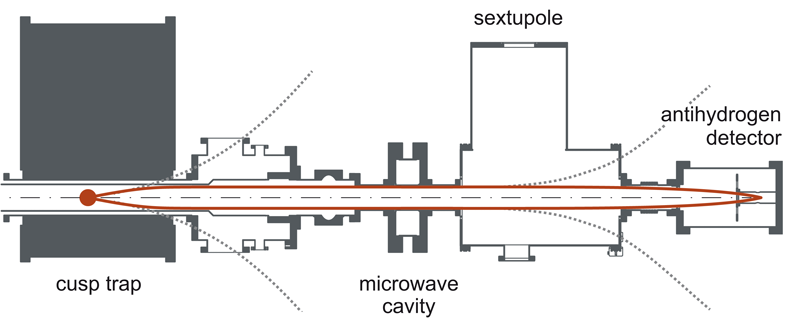Methodology
The planned measurements use a staging approach employing three methods, leading to three phases of the experiment:
- Phase 1: atomic beam with a single microwave cavity.
- Phase 2: atomic beam with Ramsey-method of separated oscillatory fields.
- Phase 3: developments towards HFS measurements with trapped antihydrogen.
Phase 1 and phase 2 are expected to be finished within the time scale of this ERC grant, yielding a relative accuracy of 10–6 to 10–7. For phase 3 initial efforts in producing an ultra-cold antihydrogen beam will be undertaken in collaboration with the AEgIS collaboration. This beam can also be used to further increase the accuracy of the HFS measurement, and ultimately to catch the antihydrogen atoms in a neutral atom trap outside the magnets needed for their formation, where laser cooling and HFS spectroscopy will be possible.
Antihydrogen HFS measurement using an atomic beam
Together Prof. Toshi Yamazaki and Prof. Eberhard Widmann had the idea to perform a measurement of the antihydrogen ground-state hyperfine structure soon after the ASACUSA experiment started operation at CERN-AD [3]. After elaborating it more the other members of ASACUSA could be convinced to make it the long-term goal of the collaboration. A Letter of Intent was submitted to CERN [4] and after positive feedback a formal addendum to the original ASACUSA proposal [5] in 2005 was subsequently approved.
The basic approach is in the first stage to follow the methods used in the early days of hydrogen by Rabi and others [6] to use an atomic beam. It has the advantage that an antihydrogen beam of temperature up to 100 K can be used, while the trapping of neutral antihydrogen atoms requires temperatures < 0.5 K. The drawback is that in this case the achievable resolution is determined by the flight time of the antihydrogen atoms through the cavity (see Fig. 2). The best value obtained for hydrogen in an atomic beam is 4×10–8 [7].
In order to produce an antihydrogen beam, members of ASACUSA proposed to use a type of trap called “cusp trap” [8] which uses an inhomogeneous magnetic field created by two Helmholtz coils with the currents running in opposite direction to confine charged and neutral particles. A major breakthrough has been achieved in 2010 when for the first time antihydrogen production in the cusp trap [9] could be demonstrated, enabling now a start of the actual measurement campaign. This achievement, together with the reported trapping of antihydrogen in the ALPHA experiment [10], was chosen by Physicsworld as “breakthrough of the year 2010”. The run in 2011 was dedicated to improving the production rate and temperature of the produced antihydrogen. The planned demonstration of the production of an antihydrogen beam could not be achieved and will be performed in 2012 at the beginning of this grant, after which first measurements are expected to start in 2012. According to theoretical calculations, a large fraction of the antihydrogen produced in the cusp trap should be in the ground state due to an efficient cooling mechanism [11].

Fig. 2: Schematic view of the atom beam line to measure the HFS of antihydrogen. It is formed in the cusp trap, whose inhomogeneous magnetic field focuses low-field seekers (solid lines) and defocuses high-field seekers (dashed lines). A microwave cavity is used to flip the spin, and a sextupole to analyse the spin direction.
